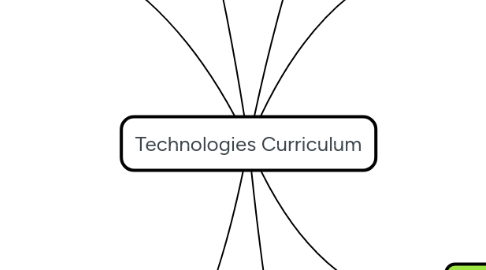
1. Digital Technologies
1.1. Students use computational thinking and information systems to define, design and implement digital solutions
1.1.1. Knowledge & Understanding
1.1.1.1. Digital systems: the components of digital systems: hardware, software and networks and their use
1.1.1.2. Representation of data: how data are represented and structured symbolically
1.1.2. Process & Production skills
1.1.2.1. Collecting, managing and analysing data
1.1.2.2. Creating digital solutions by: investigating & defining, generating & designing, producing & implementing, evaluating, collaborating & managing
2. Cross-Curriculum Priorities
2.1. Aboriginal & Torres Strait Islander Histories & Cultures
2.1.1. Interconnectedness of technologies and identify, people, culture and country/place
2.1.2. Sustaining environments, histories, cultures & identities by creating appropriate and sustainable solutions
2.2. Asia & Australia's engagement with Asia
2.2.1. Australia's engagement with Asia to create appropriate and sustainable products and services that meet personal, community, national, regional and global needs
2.2.2. Contributions that Asia makes to global technological advances
2.2.3. Traditional, contemporary and emerging technological achievements in the Asian region
2.2.4. Contributions Australia makes to create products and services that meet a range of needs in the Asian region
2.3. Sustainability
2.3.1. Students work with complexity, uncertainty and risk, make connections between disparate ideas and concepts, self-critique and propose creative solutions that enhance sustainability
2.3.2. Enables consideration of preferred futures
2.3.3. Identify and critique a problem, need or opportunity, generate ideas and concepts and create solutions, they give prime consideration to sustainability by anticipating and balancing economic, environmental and social impacts
2.3.4. Opportunities to explore own and comparing viewpoints, values and interests
2.3.5. Reflect on past and current practices and assess new and emerging technologies from a sustainability perspective
3. Key ideas/concepts
3.1. Creating preferred futures: students will begin to identify possible and probable futures, and their preferences for the future
3.2. Project management: students will develop skills to manage projects to completion through planning, organising and monitoring timelines, activities and the use of resources
3.3. Safety: the safe use of technologies as well as risks that can impact on project timelines
3.4. ICT: students develop explicit knowledge, understanding and skills relating to operating and managing ICT and applying social and ethical protocols while investigating, creating and communicating
3.5. Animal ethics
4. Design and Technologies
4.1. Students use design thinking and technologies to generate and produce designed solutions for authentic needs and opportunities
4.1.1. Knowledge & Understanding
4.1.1.1. Technologies and society: the use, development and impact of technologies on people's lives
4.1.1.2. Technologies contexts: technologies and design across a range of technologies contexts
4.1.2. Process & Production skills
4.1.2.1. Creating designed solutions by: investigating & defining, generating & designing, producing & implementing, evaluating, collaborating & managing
5. General Capabilities
5.1. Literacy
5.2. Numeracy
5.3. ICT Capability
5.4. Critical & Creative thinking
5.5. Personal & Social Capability
5.6. Ethical Understanding
5.7. Intercultural Understanding
6. Curriculum aims/objectives
6.1. Technologies aims to develop the knowledge, understanding and skills to ensure that individually and collaboratively students;
6.1.1. investigate, design, plan, manage, create and evaluate solutions
6.1.2. are creative, innovative and enterprising when using traditional, contemporary and emerging technologies, and understand how technologies have developed over time
6.1.3. make informed and ethical decisions about the role, impact, and use of technologies in the economy, environment and society for a sustainable future
6.1.4. engage confidently with and responsibly select and manipulate appropriate technologies (materials, data, systems, components, tools, equipment) when designing and creating solutions
6.1.5. critique, analyse, and evaluate problems, needs or opportunities to identify and create solutions
